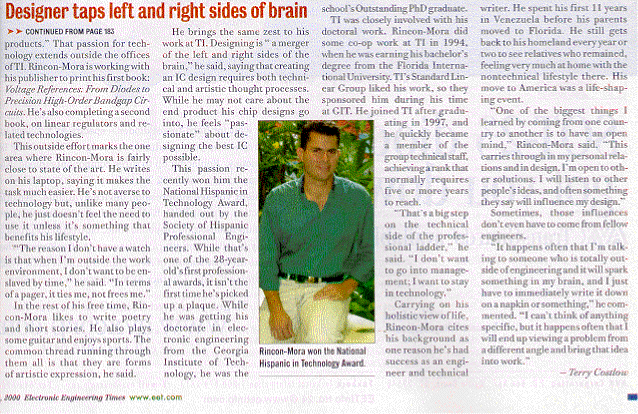



| June 16, 2000 | ||||||||||||
|
||||||||||||

|
||||||||||||
 
 Network Partners
Network Partners |
Designer has passion for work, apathy for gizmosBy Terry Costlow
"I just put a CD player in my car because I like to listen to music," said Rincon-Mora, senior IC designer at the Power Management Products unit of Texas Instruments Inc. (Dallas).
This lack of interest in most e-toys contrasts markedly with his efforts to advance the state of the art in electronics. He works with dc/dc converters, power amps and other products, and ultimately came up with power-management ICs for laptops and other portable gear.
"It's not that I don't think there is value in gizmos, but the things I derive pleasure from are not necessarily related to technology," Rincon-Mora said. "When I go into work, I'm very passionate about the job of designing products."
That passion for technology extends outside the offices of TI. Rincon-Mora is working with his publisher to print his first book: Voltage References: From Diodes to Precision High-Order Bandgap Circuits. He's also completing a second book, on linear regulators and related technologies.
This outside effort marks the one area where Rincon-Mora is fairly close to state of the art, because he's writing on his laptop, which he says makes his task much easier. He's not averse to technology, he said, but he doesn't feel the need to use it unless it's something that benefits his lifestyle.
"The reason I don't have a watch is that when I'm outside the work environment, I don't want to be enslaved by time," he said. "In terms of a pager, it ties me, not frees me."
Artistic threads
In the rest of his free time, Rincon-Mora likes to write poetry and short stories. He also plays some guitar and enjoys sports. The common thread running through them all is that they are forms of artistic expression, he said.
He brings the same zest to his work at TI. Designing is "a merger of the left and right sides of the brain," he said, adding that the creation of an IC design requires both technical and artistic thought processes. While he may not care about the end product that incorporate his chip designs, he feels "passionate" about designing the best IC possible.
This passion recently won him the National Hispanic in Technology Award, handed out by the Society of Hispanic Professional Engineers. While that's one of the 28-year-old's first professional awards, it isn't the first time he's picked up a plaque. While he was getting his doctorate in electronic engineering from the Georgia Institute of Technology, he was the school's Outstanding PhD graduate.
TI was closely involved with his doctoral work. Rincon-Mora did some co-op work at TI in 1994, when he was earning his bachelor's degree from the Florida International University. TI's Standard Linear Group liked his work, so they sponsored him during his time at GIT. He joined TI after graduating in 1997, and he quickly became a member of the group technical staff, achieving a rank that normally requires five or more years to reach.
"That's a big step on the technical side of the professional ladder," he said. "I don't want to go into management; I want to stay in technology."
Carrying on his holistic view of life, Rincon-Mora cites his background as one reason he's had success as an engineer and technical writer. He spent his first 11 years in Venezuela before his parents moved to Florida. He still gets back to his homeland every year or two to see relatives who remained, feeling very much at home with the non-technical lifestyle there. His move to America was a life-shaping event.
"One of the biggest things I learned by coming from one country to another is to have an open mind," Rincon-Mora said. "This carries through in my personal relation and in design. I'm open to other solutions. I will listen to other people's ideas, and often something they say will influence my design."
Sometimes, those influences don't even have to come from fellow engineers.
"It happens often that I'm talking to someone who is totally outside of engineering and it will spark something in my brain, and I just have to immediately write it down on a napkin or something," he said. "It happens often that I will end up viewing a problem from a different angle and bring that idea into work."

|
|||||||||||